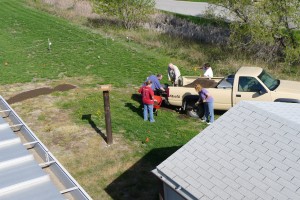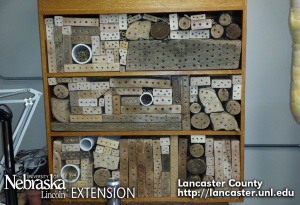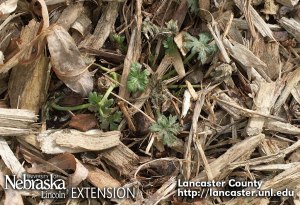This week our UNL Extension unit leader in Lancaster County Gary Bergman is retiring. We want to thank him for his years of leadership and support for creating the Cherry Creek Pollinator Habitat. After Soni and I returned from attending BOW-Becoming an Outdoor Woman in the fall of 2012, we were inspired to build a structure for pollinators and beneficial insects. We approached Gary about this project, explained our idea and its educational value. As we looked over a possible location, it became clear that we had available space behind the Extension office. The area was large enough to plant a pollinator habitat too and Gary was immediately supportive of the idea. He encouraged us to develop a plan and share it with the Extension Board members. Along the way he has helped with design ideas and always encouraged us to expand our vision. We have been grateful for Gary’s support and the opportunity to create a habitat that is educational to people and beneficial to pollinators.
MJ
Tag Archives: City of Lincoln
‘Lone Wolf’ Sawtooth
My, my, my… how one of our perennial sunflowers has grown!
We have a sawtooth sunflower (Helianthus grosseserratus) in the Cherry Creek Habitat. When grown in tight colonies the sunflowers reach 3-5 feet tall. However, when you plant one by itself (described as a ‘lone wolf’) it can reach up to 12 ft tall. This afternoon, we went out and measured the sawtooth sunflower in the Cherry Creek habitat and it is 9 ft tall. It is glorious! Unfortunately, it is too tall for the space (and could be aggressive), so we’ll have to move it later. There are plenty of pollinators on the sunflower now and it certainly is a standout in the habitat.
Other habitat news:
- Excited! Jim in our office is busy adding a camera out back so we can view the habitat on the web and share video. We should even have “night vision”.
- We’ve also been doing some nitty gritty work with weeding and adding more rock to keep working on the erosion issues with the space.
- The activity at the bee nesting structure has really slowed down, although I did see one leaf cutter bee busy at work. Bumble bees have certainly not slowed down their activity – they are still as busy as “bees”.
- Today, we saw a lot of monarchs moving south on their migration while working in the habitat.
- As we move into fall, it will be time to harvest seed and plant more plants.
- Speaking of sunflowers, the Lemon Queen sunflowers may not look as pretty now that the flowers are gone, but they are providing food for birds. This afternoon, a female cardinal and three of her young were busy feeding on the seeds.
An Idea Whose Time Has Come…
Today’s editorial in the local newspaper, the Lincoln Journal Star, focuses on the plight of bees and the United State’s efforts to do something about our pollinator populations.
From the editorial – June 30, 2014
Six years ago, at a time when news media were giving attention to the high rate of bee deaths, the Journal Star mused in a tongue-in-cheek editorial that maybe one day the nation would be forced into “dotting the landscape with national bee refuges………”
Take a moment to read the rest of the editorial on-line here.
Here’s to sharing the buzz!
Soni
UNL Extension provides research-based information to help you make informed decisions any time, any place, anywhere – http://lancaster.unl.edu
More Bee Hotels Popping Up in Lincoln
The Daily Nebraskan is a student newspaper at the University of Nebraska-Lincoln. Today the paper featured a story about “bee hotels” on East Campus and an upcoming UNL Publication – NebGuide to encourage folks to build their own.
We’re excited everyone is promoting the preservation of native bees!
Here is a link to the article in the Daily Nebraskan – “Hoping to preserve bee populations, UNL opens bee hotels”
When the NebGuide is finished, we’ll be sure to post a link. In the meantime, we have a resource for you to help get you started “Attracting Pollinators to Your Landscape“. It includes information on making bee nest boxes.
And don’t forget the bumble bees! Here is a link to build your own bumble bee domicile from the UNL Bumble Boosters.
Here’s to sharing the buzz!
Soni
UNL Extension provides research-based information to help you make informed decisions any time, any place, anywhere – http://lancaster.unl.edu
We’re getting ready for the pollinators – Spring!
It’s officially the first day of Spring!
It might not look like much to most folks, but I was doing a happy dance when I saw the purple poppy mallow in the Cherry Creek Pollinator Habitat starting to send up new leaves. This native wildflower will bloom from late spring through summer. It thrives in disturbed areas, along roadsides, ditches and overgrazed areas. In the garden, it is a sprawling plant full of beautiful magenta flowers.
While the purple poppy mallow is doing well, we’re going to have to replant the white clover. The local rabbits took care of our patch over the winter to the point where it won’t recover. Good thing I have plenty in my yard to share!
Also on our “to-do” list: Move the bee nest box structure outdoors, a stream clean-up and start expanding the habitat to the west. We have a lot to do!
We put together some information to help you attract pollinators to your landscape, along with the directions to make your own bee nest boxes…. You have plenty of time to make your own nest boxes and get them outdoors!
http://lancaster.unl.edu/pest/resources/354Pollinators.pdf
Here’s to Sharing the Buzz!
Soni
UNL Extension provides research-based information to help you make informed decisions any time, any place, anywhere – http://lancaster.unl.edu
Landscaping for Pollinators – Nebraska Statewide Arboretum
Our friend and colleague, Kendall Weyers from the Nebraska Statewide Arboretum, recently wrote a nice article on landscaping with pollinators….Thanks Kendall!
Kendall – “Mention pollinators in the landscape, and the first thought of most homeowners is the butterfly. Everyone loves to see this beautiful creature floating on a summer breeze, and some gardeners select plants specifically for them.”
“Yet it is important to remember there is a long list of pollinators beyond butterflies. A wide range of bees, beetles, moths, flies, ants, birds and even bats all play an important role in pollination. Unfortunately these roles and their effectiveness have diminished in our highly fragmented or entirely altered native ecosystems. Weather changes, heavy use of non-native plants and pesticide use also have contributed to the decline of pollinators.”
Be sure to visit the Nebraska Statewide Arboretum Web site and blog for more information on pollinators, plants and our landscapes. http://arboretum.unl.edu/
Enjoy!
Here’s to Sharing the Buzz!
Soni
UNL Extension provides research-based information to help you make informed decisions any time, any place, anywhere – http://lancaster.unl.edu
It rained!
It rained last night. Most of Nebraska is still in a drought – every drop of rain helps! I hope when we get back to the office on Monday the berm we started is still intact and held the runoff from the office roof. If not, that’s OK. The berm is a work in progress – we’ll shore it up.
I’m sure the plants/wildlife at the neighboring saline wetlands appreciate the rain. You know, we haven’t talked about our neighbors. Just to the north of our Cherry Creek site, is an amazing resource few people know about. It is the Lincoln Saline Wetlands Nature Center, 92 acres of unique habitat. Map
What’s a Saline Wetlands? From the Lower Platte South Natural Resources District who manages the sites in our area: “When the ground water rises to the surface a wetland is created. When that water passes through salt deposits on its way up, a saline wetlands is created. Lincoln, Nebraska is one of the very few places on earth where that happens…. ” Continue reading






